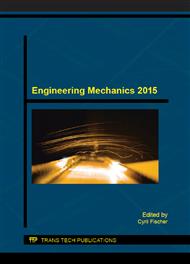p.303
p.309
p.317
p.325
p.331
p.341
p.349
p.357
p.364
Parallel Computing Procedure for Dynamic Relaxation Method on GPU Using NVIDIA's CUDA
Abstract:
This paper introduces a procedure for parallel computing with the Dynamic Relaxation method (DR) on a Graphic Processing Unit (GPU).This method facilitates the consideration of a variety of nonlinearities in an easy and explicit manner.Because of the presence of inertial forces, a static problem leads to a transient dynamic problem where the Central Difference Method is usedas a method for direct integration of equations of motion which arise from the Finite Element model.The natural characteristic of this explicit method is that the scheme can be easily parallelized. The assembly of a global stiffness matrix is not required.Due to slow convergence with this method, the high performance which GPUs provide is strongly suitable for this kind of computation.NVIDIA's CUDA is used for general-purpose computing on graphics processing units (GPGPU) for NVIDIA's GPUs with CUDA capability.
Info:
Periodical:
Pages:
331-337
Citation:
Online since:
January 2016
Authors:
Price:
Сopyright:
© 2016 Trans Tech Publications Ltd. All Rights Reserved
Share:
Citation:


